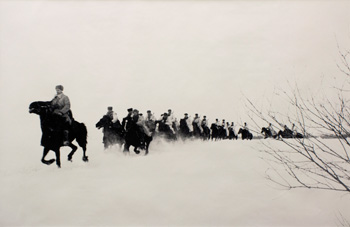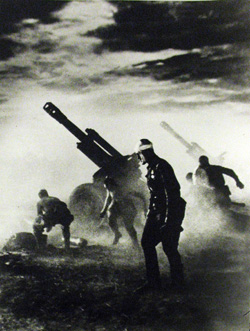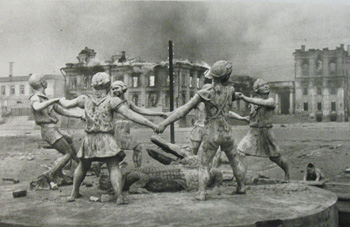Arts
Exhibit
Exhibit: Through Soviet Jewish Eyes

This collection of photographs, on display at the Museum of Jewish Heritage–A Living Memorial to the Holocaust, explores the work of Soviet Jewish photographers during the 1930s and 40s. It traces the dramatic impact of World War II on the subjects and stylistic elements of Soviet imagery of the period: Before the war, Soviet photojournalists had been trained to capture images of vigor and happiness that exalted the new socialist society: shows of military and technological strength, industrious workers plying their trade, bounties of produce. Mark Markov-Grinberg’s Aviation Parade, taken for the Telegraph News Agency of the Soviet Union, shows a group of military planes form the Soviet star from the perspective of an onlooker, watching from the ground in awe. In the geometrically compelling Running Up the Steps of the Lenin Library, Soviet photographer Georgi Zelma captured a group of children at play on the threshold of an important state educational institution. These photos, stylistically avant-garde, yet motivated by a desire to politicize their audience, are examples of the Socialist Realism movement of photography that was in vogue at the time; defined by dramatic angles, stark contrasts, and idealized subjects, the photographs give the viewer an understanding of the interplay between politics, propaganda and art that shaped Soviet photography of the period.

Emmanuel Evzerikhin. Gelatin Silver Print.
Gift of Teresa and Paul Harbaugh,
CU Museum of Art, University of Colorado Boulder.
But with the start of the war, the communications priorities of the USSR changed—and with it, the visual content of its magazines and newspapers. As photojournalists were sent to document the movements of the Red Army, photos celebrating civilian life gave way to images of battle and carnage. The propaganda value of many of these wartime photographs—shows of Soviet military heroism and strength—is still discernible. But, using the same dramatic techniques that were in vogue before the war, Soviet photojournalists imbued many of the images with an emotional power and timelessness not present in the more politicized prewar work on display.
Mark Markov-Grinberg’s photo of soldiers in the trenches demonstrates both tendencies: Dominated by a tank that dwarves their crouching bodies—a show of Soviet technological power—it nonetheless conveys the human aspect of the conflict, showing the soldiers’ faces and the scale of the machinery of war. Urban destruction was also a constant theme, as photographers documented the destruction caused in soviet cities by bombing and siege. Evgenii Khaldei, one of the most well-known and successful Soviet photographers at the time, shot the widely circulated Chimneys of Murmansk, a Soviet city that was fire-bombed in 1942. The stark, bombed-out factory chimneys convey a industrial strength and vivacity ruined by the war.

Emmanuel Evzerikhin. Loan from Teresa and Paul Harbaugh.
Photo: CU Art Museum.
The wartime photos also broaden the viewer’s perspective of an event whose visual history has become almost archetypal. Nazi atrocities in the East—villages laid waste, cities buckling under siege, ditches dug as mass graves—were captured by Soviet photographers years before Western images of liberated concentration camps and survivors came to represent the tragedy of the Holocaust. Baltermants’s powerful photos of Kerch, one of the villages massacred by the notorious Einsatzgruppen, show families weeping over the corpses of loved ones strewn beneath an ominous, cloud-streaked sky. For many Soviet Jewish photographers, the experiences were personal: In 1943, Khaldei photographed the liberation of his hometown and discovered that many of his family members had been murdered in the Holocaust.
Through April 7 at the Museum of Jewish Heritage–A Living Memorial to the Holocaust, New York (www.mjhnyc.org).








 Facebook
Facebook Instagram
Instagram Twitter
Twitter
Leave a Reply